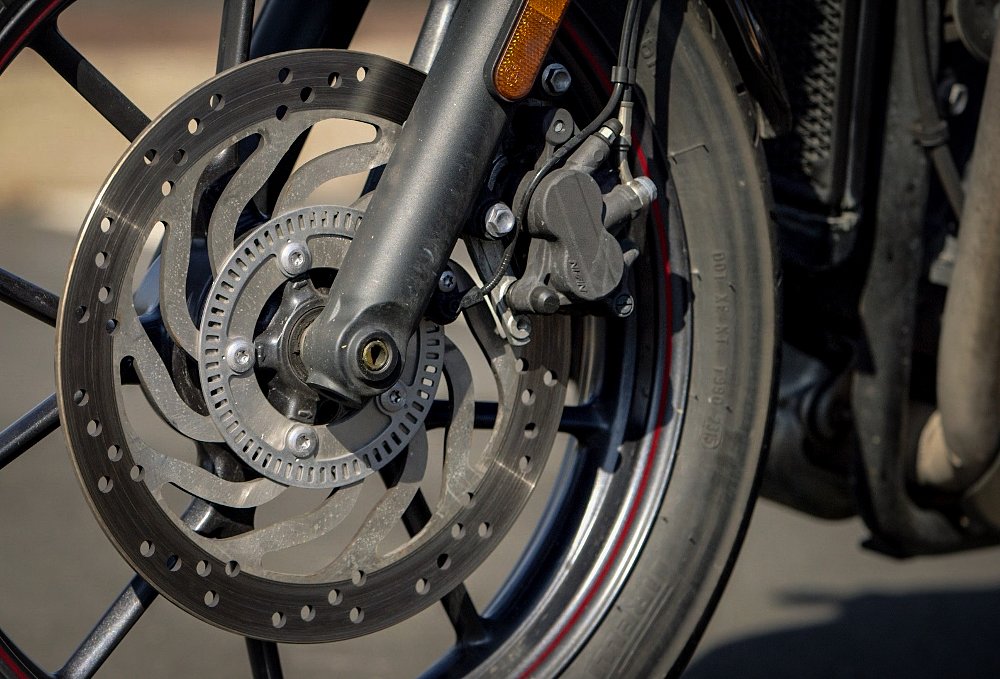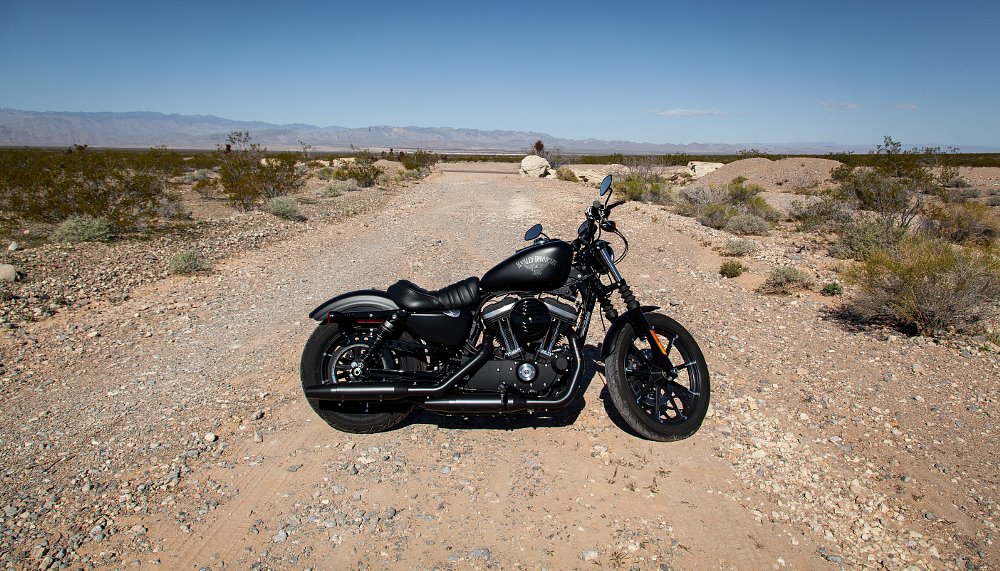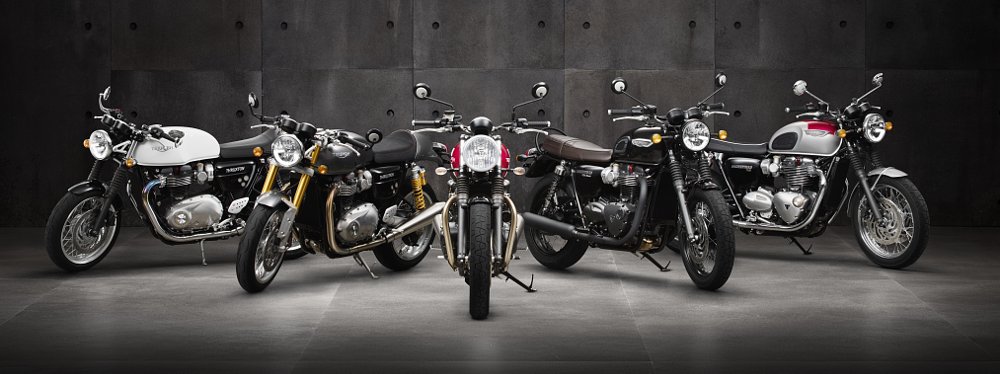By the time the side stand scraped the concrete in front of my Philadelphia apartment in the early hours of the morning, I had traveled more than 1,700 miles in just under 48 hours on a new Triumph Street Twin.
This brought my grand total to just shy of 3,000 miles over seven days. Starting at Triumph’s U.S. headquarters in Atlanta, I rode the new Street Twin down to Austin, Texas. After a weekend full of music, MotoGP, and the Third Annual Handbuilt Show, it was time to mosey on.
I had to get the bike back to Philadelphia in time to keep with our schedule of shooting the video portion of this month's review. This meant burning highway miles at a breakneck pace. With the miles came plenty of adventure and experience to pull from as we break down Triumph’s new Bonneville Street Twin.

The bike
So is it a Bonneville? Or a Street Twin? Or a Bonneville Street Twin? Triumph seems to have a lot of different names for these new bikes. It appears that “Bonneville” will now be the overall family name with different models sitting underneath the moniker, much like they used to refer to the entire family as “Modern Classics.” What’s that you say? They still refer to the entire family as Modern Classics? Well, that could be a bit confusing.

Regardless of what you call it, the Street Twin replaces the base Bonneville and is sporting the smallest engine in the new family of classically inspired motorcycles. Since its introduction in 2004, the 865 cc, air/oil-cooled parallel twin had become a mainstay in Triumph's lineup. The smaller 790 cc engine hung around for a while, but by 2009, the 865 cc plant was powering six models, nearly half the bikes in Triumph’s catalog. To say that Triumph was taking a risk by altering this recipe for success is a bit of an understatement. After my time with this bike, I would say the gamble has paid off.

On the old engine, the torque curve could have better been described as a straight line delivering around 50 foot-pounds of torque from 3,500 rpm to almost 7,500 rpm, before falling off to the redline at 8,000 rpm. The new 900 cc mill stomps out 59 foot-pounds almost immediately at 3,200 rpm before dropping off steadily to the 7,000 rpm redline.
What you get is an engine that feels bigger than it is. You get gobs of low-end and mid-range power, at the expense of top-end peak performance. I imagine the majority of riders looking at this bike will appreciate where Triumph has placed the power. It’s ideally located for real-world riding.

It also sips fuel. And that’s a good thing, considering the capacity of the gas tank was reduced to 3.2 gallons. I was averaging around 58 mpg down to Austin and back. Keep in mind that I weigh 205 pounds and was rocking about 45 to 50 pounds of gear. Not too shabby.
In an early press release, it looked like the Street Twin was going to be getting a six-speed gearbox, much like its larger siblings, the T-120 and the Thruxton. Instead, it maintains a five-speed, but overall gearing has been revised and it feels more comfortable chasing highway speeds. I rode it across Texas at an indicated 70 mph (or more) for hours on end and it felt just fine. I would have killed for a windscreen, though.
In reality, this bike is more comfortable strolling down country highways and stopping in small towns to strut around like a peacock with full plumage extended. It begs attention. The lines of the new Street Twin attract as many (if not more) onlookers as the old Bonnie. The new tire sizes offer up increased vintage appeal. An 18-inch wheel up front replaces the old 17-inch rim on the Bonneville and looks more at home with the rest of the retro styling.

The chassis has been redesigned to accommodate these changes, and while the Street Twin retains the neutral steering feel the Bonneville was known for, it also retains its sub-par suspension. While it receives about an additional 0.75 inches of travel in the rear, this is the first thing I would look to replace.
The braking system gets updated to include ABS, an addition many riders have been asking about for years. The addition of ABS means you can grab a big ol’ handful of that brake lever without worrying about disrupting the chassis. While the Street Twin doesn't get the bump to a dual-disc setup, like the T-120 and Thruxton, the single 310 mm rotor and two-piston Nissin caliper up front work nicely with the 255 mm rotor and Nissin pairing at the rear wheel to provide solid stopping power. It's the right tool for the job of stopping a 55-horsepower motorcycle.
Traction control is also new for 2016 and works to monitor wheel slip over less than ideal conditions. While traction control can be disabled, ABS cannot.

Throttle response is spot on. Compared to the new Thruxton R I got to ride, the Street Twin's throttle-by-wire system delivered a smooth transition both on and off the gas. While there are no throttle modes like on the Thruxton and T-120, there is no abrupt on/off feel, either.
The overall ergonomics offer a sporty seating position. When I used to modify Bonnevilles for friends, the first change I would make would be to swap out the bars for a set of dirt bars. With the new Street Twin, it seems Triumph has beat me to the punch with a nice set of low-slung bars placing you in a lower tuck than the previous generation.
At six feet, three inches, I felt a bit cramped on the new 29.5-inch seat height. While I would have liked a bit more height for my rear end, new and shorter riders will be sure to appreciate the quick and confident reach to the ground.
Testing the Street Twin
I had a blast riding this bike down southern roads while soaking up the local culture and cuisine. I explored small towns in north Georgia and Alabama and watched the sunset on the Gulf of Mexico. The Street Twin looked perfectly at home in those sleepy southern towns, some of which looked to be stuck in another place in time, much like the styling of the Street Twin.

The Street Twin shines on 55 mph country highways with plenty of stops to look around and explore. Stay too long in the saddle and you’ll start to get sore and restless. Its small stature and nimble handling made it a breeze for bopping around while my old Cortech luggage offered up simple storage with enough room for a few days on the road.
I enjoyed oyster po’boy sandwiches in Montgomery and beignets at Café Du Monde in New Orleans. I stopped in Pascagoula, Miss., to search for a lost juke joint I learned of in a Jimmy Buffett song. I found old-timers sitting on the bike in the mornings when I emerged from my hotel room and in the afternoons when I stopped for gas or lunch. They had questions regarding the new Street Twin and a lifetime of stories to tell about old Triumphs. (Keep an eye out for a full article on my adventures exploring the South)

Having wrapped up the first half of the trip in Austin watching Marc Márquez cross the finish line at Circuit of The Americas to claim victory, it was time to head home.
I pulled into Philadelphia 48 hours after leaving Austin. I was damn near frozen solid as temperatures had plummeted to 38 degrees after torrential rains permeated my rain gear and drenched me to the bone. As I piled my wet clothes in the bathtub, my girlfriend called me a few choice expletives and insisted I was an idiot for not pulling over and getting a hotel room.
"There is no story to be found in a hotel room," I argued.
My position fell on deaf ears.

The Street Twin got me home, but it was never designed to tackle those kinds of miles in that timeline. A windshield would have helped; a bigger bike would have helped more. I think the Street Twin makes a great touring machine, as long as your tours don’t exceed 300 miles per day.
Street Twin highlights
The standout here is the engine. I want to pull the engine out of this bike and stick it in my old 2005 T-100. It’s that good. Even Lemmy agrees with me, as he felt it was a stouter engine than the one found in the Sportster he is currently modifying. The exhaust sound is just as impressive. In my opinion, Triumph did such a great job on the stock exhaust you will never feel the need to upgrade to an aftermarket setup. Sorry Vance & Hines!

Speaking of the engine, the long service intervals — 10,000 miles for regular service — should make the Street Twin one of the less maintenance-intensive bikes on the market. This is great for new and veteran riders alike who want the look of an older machine with modern reliability.
The integration of electronics is seamless. The ABS system works great to slow the bike fast without unsettling the rider. The traction control doesn’t engage too early and in the few dusty spots where it did, it did so very smoothly. It is also easy to disable if you want to use all that new-found torque to try lofting the front wheel.
Subjectively speaking, the overall looks are fantastic. I really liked the new, slimmer tank compared to the old Bonnie's bulbously bloated one, even if it means it holds less fuel. The dropped bars, revised headlight mount, LED tail light, shorter fenders, revised dash, and sharp lines manage to make this bike look simultaneously more vintage and modern. The 18-inch front wheel adds a lot to that.

In order to accommodate the new wheel sizes, adjustments to the chassis had to be made to maintain the nimble handling characteristics found on the old bike. While I was disappointed with the suspension, the overall handling was quite sharp. This bike was a blast around town as well as through the corners. It has a sporty streak and begs to be pushed and abused more so than the older bike.
Street Twin lowlights
Those tire sizes come with a negative side. The Street Twin wears a 100/90-18 up front and a 150/70R17 out back. This makes it damn near impossible to find extensive rubber options for the front wheel while plenty exist for the rear. This problem is inverted over the old bike, where the rear tire was the one impossible to shop for. I found this out the hard way by snagging a flat tire about 100 miles outside of Austin.
After limping into town with a plug, I learned that while I could get a Michelin Pilot Road 4 for the rear, there was no match for the front. If you take a closer look at some of the zoom shots in the video you’ll notice the different tires on the bike. While we don’t recommend mixing and matching tire manufacturers, sometimes you do what you have to do to make it home.

The most noticeable problem with this bike is the suspension. Some things never change. While I understand it is hard to build one bike to fit everyone, this suspension is all but maxed out with just myself aboard. As I mentioned earlier, I am 205 pounds, which is probably a bit heavier than the average rider, but assuming the average falls around 165-175 pounds and then adds gear or a passenger, they’ll be well past my solo weight. I’m interested to see what options become available for this bike. I like the Ohlins shocks I’ve used on Bonnies in the past while my buddy (and fellow Zillan) Andy has been quite happy with his Progressive shocks.

It could be argued that the lure of customization was a huge selling point for the previous generation Bonneville. The old bikes had such an extensive aftermarket surrounding them, it was easy for new and inexperienced mechanics to create a custom machine while learning along the way. I fear it will be a hot minute before we see the aftermarket catch up to these new bikes. Because this will require all new designs, castings, and production, expect to see the costs of these new parts sit higher than the older parts, where the initial costs have already been absorbed over time.
The updated style of the bike means a lot of these parts, especially the fenders, are now plastic, abandoning their metal roots. It also means no more fake carburetor bodies and no enrichener switches masquerading as chokes. On cold morning starts (as well as a few in the afternoon), the bike was hard to start. It would stall after a few seconds. Usually after the second restart it would stay running, but this is something I would expect to see Triumph address with an ECU flash update. If nothing else, I would recommend trying to have your local dealer re-flash the ECU with the “race” tune.
There were a few little things that drove me insane during my trip. At night, the high beam indicator shone so brightly blue it distracted me from the ride. The seat, while stylish, was highly uncomfortable for any extensive period of time. I don’t know how Triumph always manages to give me mirrors that show me nothing but my shoulders, but they nail it every time. I thought it was mostly because of my size, but some of the shorter people around the office cursed the mirrors as well.
Competition
Ten years ago, Triumph had this “Modern Classic” category almost entirely to themselves. Currently, there are plenty of manufacturers looking to capitalize on this craze of retro styling.

The Street Twin carries an MSRP of $8,700 in Jet Black, while any additional color will bump the price to $8,950. This puts it in the same range as bikes like the Harley-Davidson Sportster 883 ($8,849 MSRP), Moto Guzzi’s V7 II Stone ($8,990 MSRP), and the extremely successful Ducati Scrambler ($8,895 MSRP).
As Lemmy addressed in his recent Sportster review, the 883 boasts one of the most supported aftermarkets in motorcycling today. The Moto Guzzi V7 II Stone gained a sixth gear on the transmission this past year and the Ducati weighs nearly 75 pounds less than the Triumph. However, the engine in the Street Twin is more impressive than any of the ones found in these other models, except for possibly the Scrambler.

While it can’t beat the Scrambler on peak horsepower, the Street Twin's torque numbers speak for themselves, as do the long service intervals. ABS is not standard on the Sportster. It’ll run you an additional $795. The fact that Triumph includes traction control as standard equipment sets the Street Twin apart from almost all bikes at this price point.
Conclusion
I have 74,000 miles on a 2005 Bonneville T-100 sitting in my garage and I have ridden countless miles on every other bike in Triumph’s old Modern Classic lineup. By the time I returned the Street Twin, I had tackled just over 3,500 miles in total, covering quiet country roads, bustling interstate traffic, as well as my daily commute through Philadelphia. I had a blast, despite the fact that the new, lower seat height feels a bit small for me.
For the first time since its introduction in 2001, Triumph’s Modern Classic line of motorcycles has received a ground-up redesign of nearly every component, starting with the engine. So far, the Street Twin has been leading the charge forward for this new line of liquid-cooled classics. When it’s all said and done, Triumph built a better bike. While no bike is perfect, and there are some things I would change, Triumph did a good job of developing a bike that carries on the traditions of its past while embracing future trends and modern amenities.
























